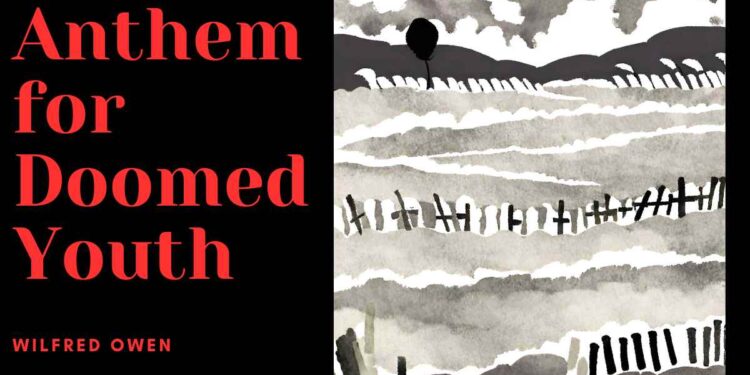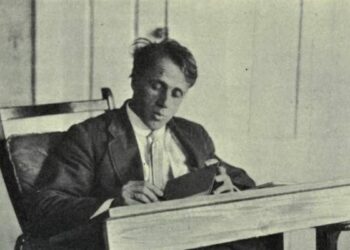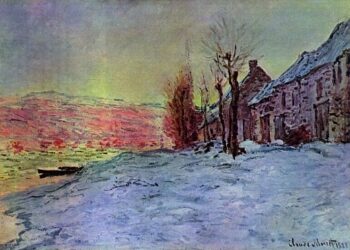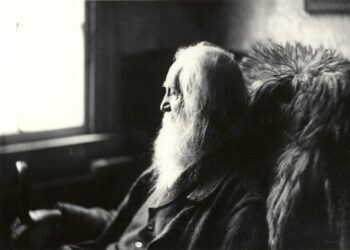Introduction
Anthem For Doomed Youth Summary By Wilfred Owen “Anthem for Doomed Youth” is one of Wilfred Owen’s most powerful and evocative poems. Written during World War I, it critiques the brutal reality of war, particularly the experience of young soldiers. The poem explores the sorrow and loss that the soldiers face and contrasts these emotions with the glorified and idealized images of war that were often propagated by the media and authorities. Owen, who was a soldier himself, uses his poetry to give voice to those who perished on the battlefield, confronting the reader with the grim reality of war.
The poem reflects Owen’s growing disillusionment with the ideals of heroism and patriotism that were often associated with war. His focus is on the futility and senselessness of conflict, as well as the emotional and physical toll it exacts on young men. Through his use of stark imagery, metaphor, and traditional poetic forms, Owen transforms the conventional “anthems” of war into a lament for those who were doomed by the horrors of combat.
In “Anthem for Doomed Youth,” Owen encapsulates the tragedy of war, especially the fate of soldiers who die in battle and are denied the traditional rites of mourning. The poem offers a powerful critique of how societies value human life and the cost of war, making it one of the most significant works in English literature about the First World War.
Summary of “Anthem for Doomed Youth”
“Anthem for Doomed Youth” is a sonnet, which is a traditional 14-line poem typically used for themes of love or beauty. However, Owen subverts this tradition by using the sonnet form to convey the brutal reality of war. The poem is divided into two main parts: the first focuses on the way soldiers die in war, and the second reflects on the emotional and spiritual cost of that death.
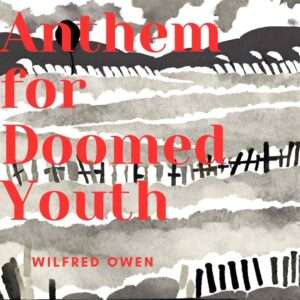
In the opening octave (the first eight lines), Owen depicts the deaths of soldiers on the battlefield as violent, brutal, and dehumanizing. The soldiers do not die with the honor or dignity typically associated with war. Instead, their deaths are marked by the sounds of battle: the “shrill, demented choirs of wailing shells” and the “monstrous anger of the guns.” These references to the noise and violence of war emphasize that the soldiers’ deaths are impersonal and chaotic, lacking the solemnity of traditional funeral rites.
Read more
The “wailing shells” symbolize the grief and the devastation caused by war, while the “anger of the guns” highlights the relentless and mechanical nature of battle. Owen suggests that the battlefield itself is the setting of their death, and their lives are sacrificed for a cause they likely do not fully understand or believe in. In these first eight lines, Owen makes it clear that the soldiers’ deaths are anything but heroic.
In the sestet (the final six lines), Owen contrasts the unceremonious nature of these deaths with the traditional rituals of mourning. Instead of the “prayers” and “bells” that would normally accompany a funeral, the young soldiers are left with nothing but the noise of battle and the absence of a proper farewell. Owen reflects on the lack of closure for these soldiers, who are denied the comfort of family, community, and spiritual rites. The only “prayers” they receive are the “pale incense” of their comrades’ memories. Owen compares these memories to the “sweet sad sounds” of a distant organ, evoking an image of a funeral, but one that is unattainable for the soldiers.
The “Anthem” in the title is, therefore, a bitter irony. It refers to the idea of a nationalistic song celebrating the bravery and sacrifice of soldiers, but Owen turns this idea on its head by showing that the true “anthem” of war is the pain, the bloodshed, and the waste of life that it leaves behind.
Read more
Themes of “Anthem for Doomed Youth”
- The Futility and Brutality of War
One of the primary themes of the poem is the futility and brutality of war. Owen critiques the idea of war as a noble or glorious endeavor. Through imagery such as “shrill, demented choirs of wailing shells” and “monstrous anger of the guns,” Owen illustrates the chaos and violence of war, portraying it as a senseless destruction of life. The soldiers are shown to die not in a noble, heroic manner but in a way that is dehumanizing and devoid of dignity.
The title itself, “Anthem for Doomed Youth,” emphasizes that these young men are doomed before they even step onto the battlefield. The anthem, which is often associated with celebration, is here a symbol of tragedy and loss. Owen’s view of war is far from romanticized; it is a destructive force that robs young men of their lives and their potential.
- The Loss of Youth
The poem also explores the theme of the loss of youth. The soldiers in the poem are described as young men who die prematurely, deprived of the chance to grow old, have families, or live fulfilled lives. Owen uses the phrase “doomed youth” to underscore the tragic waste of young life in the war. These young soldiers are not just dying in battle—they are being robbed of their futures, which makes their deaths even more tragic.
- The Absence of Rituals of Mourning
Another central theme in the poem is the absence of traditional rites of mourning. In the second part of the poem, Owen contrasts the death of soldiers with the typical rituals of remembrance, such as prayers, bells, and memorials. The young men who die on the battlefield are not given these traditional comforts. Instead, their deaths are marked by the sounds of war and the violence of their surroundings. This absence of ritual mourning highlights the dehumanizing nature of war and the fact that the soldiers are not treated with the dignity they deserve.
- The Powerlessness of the Individual in War
Owen also explores the powerlessness of the individual soldier in the face of war. The soldiers are portrayed as powerless victims of circumstances beyond their control. They are sent into battle by figures of authority who are detached from the reality of the battlefield. Owen’s use of terms like “wailing shells” and “anger of the guns” suggests that the soldiers are swept up in a larger, uncontrollable force that renders them powerless. They are not heroes but victims of a war that they cannot escape.

- The Role of Memory
Finally, the poem also deals with the theme of memory. In the last lines, Owen reflects on how the soldiers’ deaths are remembered, and how the memories of their comrades serve as a form of mourning. These memories, however, cannot replace the rituals of family and community mourning. Instead, they exist as “pale incense” that offers no real solace. Owen suggests that memory is both a form of tribute and a painful reminder of what has been lost.
Read more
(FAQ)
1. What is the main theme of “Anthem for Doomed Youth”?
The main theme of “Anthem for Doomed Youth” is the brutal reality and futility of war. Owen critiques the glorified notions of war by depicting the harsh, dehumanizing experiences of soldiers. The poem emphasizes the premature death of young soldiers and the lack of traditional rituals of mourning for them.
2. Why does Owen use the sonnet form in “Anthem for Doomed Youth”?
Owen uses the sonnet form, a traditional poetic structure often associated with love or beauty, to subvert the romanticized notions of war. By using this form, Owen highlights the contrast between the idealized concept of war and the grim reality faced by soldiers. The sonnet’s regular rhythm and structure serve as a backdrop to the dissonant and chaotic imagery of war, intensifying the emotional impact of the poem.
3. What does the title “Anthem for Doomed Youth” mean?
The title “Anthem for Doomed Youth” is ironic. An “anthem” is usually a celebratory or patriotic song, but in this poem, it refers to a tragic and mournful tribute to the young soldiers who die in war. The soldiers are “doomed” because they are sacrificed by the brutal, senseless nature of war, which leaves them no chance for a normal life or proper mourning.
4. How does Owen portray the deaths of soldiers in the poem?
Owen portrays the deaths of soldiers as violent, impersonal, and chaotic. The soldiers are killed in battle, surrounded by the sounds of gunfire and shells, with no proper burial rites or moments of mourning. Their deaths are not dignified or heroic; instead, they are tragic and senseless.
5. What is the significance of the absence of funeral rituals in the poem?
The absence of funeral rituals in the poem highlights the dehumanizing and impersonal nature of war. In contrast to the traditional rituals of mourning, such as prayers, bells, and eulogies, the soldiers in the poem are denied these comforts. This absence underscores the harsh, brutal environment of the battlefield and the emotional toll that war takes on those who fight in it.
6. How does Owen use sound imagery in the poem?
Owen uses sound imagery throughout the poem to convey the violence and chaos of war. Phrases like “wailing shells” and “anger of the guns” evoke the horrific sounds of battle, emphasizing the relentless and destructive nature of the conflict. These sounds contrast sharply with the quiet, solemn rituals of mourning that are typically associated with death.
Read more

